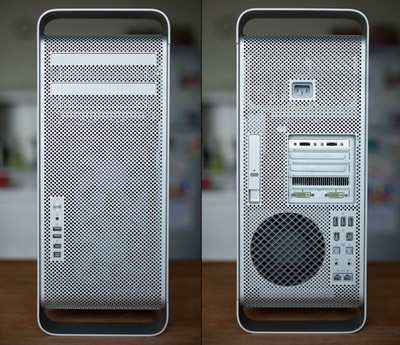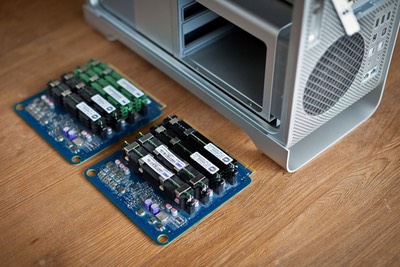
Expensive trash can?
Back in 2013, Apple introduced the new Mac Pro, an amazing wonder of design. But it was also a study in compromise for "Pro" users, requiring all peripherals to be externally attached, and not allowing for any after-purchase upgrades (video card, CPU, etc.). It was also shockingly expensive.
I can only imagine how hard it must have been for Apple to try to build a perfect Mac "Pro" desktop for everyone. As nicely designed as the new Mac Pro was, it missed the perfect mark for many Pro users by quite a bit.
So how does Apple try to design one Mac that can satisfy a diverse group that encompasses design professionals, gamers, scientific researchers, video creators, and who knows what else? Quite simply, they shouldn't try, as such an exercise is destined to fail. (See "new Mac Pro," above.)
Instead, Apple should design one Mac that can become anything and everything to each type of "Pro" user. While that may sound daungting, the good news is that Apple's already done this in its recent past. And done it very well, I might add…

One Mac to rule them all
When has Apple done this in the past? As recently as 2012, the last year of production for the old Mac Pro. That's right, the old Mac Pro.
The 2012 Mac Pro was the best Pro-level Mac Apple's ever made. They should make it again.
Is the thing the size of a small house? Yep. Is it heavy? Yep. Can it fit comfortably on your desktop, like the new Mac Pro? Nope. Is it visually appealing to anyone but a serious Mac nerd? Nope. Does it contain more aluminum than most cars? Yep.
 Despite all that, the old Mac Pro is the best Mac for any type of Pro user you'd care to imagine. Why?
Despite all that, the old Mac Pro is the best Mac for any type of Pro user you'd care to imagine. Why?
Not because it's an elegant, tiny design that looks great on your desk. Just the opposite, in fact: Because it's a huge, powerful, nearly-empty box that's ready to become whatever anyone wants it to be.
In case you doubt that, here's a list the old Mac Pro's main features…
- Four 3.5" internal drive bays
- Two externally-accessible optical drive bays
- Four, six, or 12 CPU cores
- Four or eight RAM slots, supporting up to 64GB of RAM in some models
- Two 10/100/1000 Ethernet ports
- Five USB ports, with two on the front panel
- Four FireWire 800 ports, with two on the front panel
- Two 16-lane and two four-lane PCI Express 2.0 expansion slots
- An optional Mac Pro RAID card
- A choice of full-size discrete video cards
- Dual- and Quad-Channel 4Gb Fibre Channel card
- Dual headphone jacks, with one on the front panel
- Built-in wi-fi and Bluetooth, of course
- Optical audio out and in
The beauty lies in the details
 All of this was housed in a chassis that was incredibly easy to open and work in—lift a lever in back, and then remove the entire side of the machine.
All of this was housed in a chassis that was incredibly easy to open and work in—lift a lever in back, and then remove the entire side of the machine.
 The internal drive bays were works of engineering genius, locking into place with a click, yet easily removed for replacement.
The internal drive bays were works of engineering genius, locking into place with a click, yet easily removed for replacement.
 Two of the USB ports, and two of the FireWire ports (along with an audio jack) were on the front of the case.
Two of the USB ports, and two of the FireWire ports (along with an audio jack) were on the front of the case.
 Need to add RAM? Drop the side panel, and the RAM board (or boards in some models) pulled right out.
Need to add RAM? Drop the side panel, and the RAM board (or boards in some models) pulled right out.
 Unlike many homebuilt PCs—including mine!—the inside of the Mac Pro was spectacularly well built—nearly every wire was hidden, and all that was visible was neat, ordered, and logical in both its design and function. To me, this machine was the pinnacle of Apple's desktop machine hardware design.
Unlike many homebuilt PCs—including mine!—the inside of the Mac Pro was spectacularly well built—nearly every wire was hidden, and all that was visible was neat, ordered, and logical in both its design and function. To me, this machine was the pinnacle of Apple's desktop machine hardware design.
The newer new old Mac Pro
So how does Apple top that design with a new Mac Pro? It's simple: They don't. There's no need to reinvent the wheel; just update the tech in the 2012 era Mac Pro, and Apple could meet the needs of a huge percentage of its Pro users—and probably other "non Pro" users as well. But beyond just meeting their needs, such a machine might help get them (myself included) more excited about the Mac again.
Out with FireWire and USB2; in with Thunderbolt 3, USB3, USB-C, SSDs, etc. Don't muck with the general design, though: Keep the four internal drive bays. Keep the expansion slots, but update to the latest version of PCI Express. Keep the dual RAM boards—with 16GB chips, the machine could handle 128GB of RAM. Support a number of high-end video cards from both AMD and Nvidia. Let third-party peripheral card makers know that there's an expandable Mac on the market again.
Such a design also has a wondrously-long useful life, because everything can be easily upgraded by the user—new hard drives, new video card, even the CPUs could be upgraded in the older Mac Pro.
This longevity is shown in the market for used Mac Pros—eBay sold listings include some units for over $3,000, with most in the $1,000 to $2,000 range…for a four-year-old (at least) Mac.
In short, I think Apple should take that amazing machine they've already designed, bring its tech forward to 2017 standards, and sell it. Costs will be relatively low—so profits will be high—as the majority of the engineering work is already done, and work on newer Macs means the company already knows how to work with Thunderbolt 3, USB-C, etc.
Truly one Mac to rule them all
With such a machine, Apple could meet the needs of everyone from gamers (moderate RAM needs, not overly concerned about cores but want fast CPU and video card) to video editors (lots of drive space, RAM, CPU cores, expansion cards) and everyone in between.
Apple could even offer a number of pre-built configurations—Gamers, Video Editors, Scientists, etc., and then let users go crazy with add-on drives, cards, etc. for their machines. At Apple's usual markup, this would bring even more profits for the company.
Pro users want a Mac that lets us do what we want and need to do—even if that's just "play games"—and I think a modernized, fully-expandable version of the 2012 Mac Pro would be just such a Mac.
I realize this is a total fantasy, and Apple will never reintroduce this glorious hardware design. Perhaps, though, they could modernize the case, shrink it down a bit, but still sell a Mac with lots of room for internal drives, a customizable video card, and room for customer-provided expansion cards. One can dream, right?
YES, I LOVE this platform - I started with the original MacPro1,1 in 2006 and lived with it another 8 years after upgrading the same chassis to a MacPro2,1 with a firmware tweak, Xenon quad-core CPU upgrade, more advanced graphics cards and an SSD.
When that system started to lose ground (and compatibility) with Mavericks and beyond, I purchased the base 2009 model MacPro4,1 chassis on eBay for $1K, reflashed the firmware to make it a MacPro5,1 and installed dual hex-core 3.5GHz CPUs (used, from eBay again) and recent-vintage Nvidia GeForce graphics and 1TB of SSD. (Gotta love that PCI bus.)
So for far less than $2K I got a totally MacOS-compatible machine that kicked ass on Apple's $4K trashcan Mac. What CAN'T you do with this thing?!?
Surely you jest...
My only answer is this: http://www.macworld.com/article/2146360/lab-tested-the-mac-pro-daisy-chain-challenge.html
Apple will of course never do this. But a clone maker could. And they wouldn't be competing with Apple.
If Apple are giving up the hi end niche pro market, why don't they give it to a clone maker?
BRAVO !!!
This Mac would be a huge improvement if it had T Bolt, at least four ports. No one has made a compatible T Bolt PCIe card, and I don't know why. Updated CPUs, etc. Apple doesn't seem to ever take into consideration that we've gone with hard drives that are compatible with our Macs. Firewire, Thunderbolt, etc. So when Apple decides to change port configs, or simply dump ports on their systems, then our drives with years of work on them have enormous interface problems. So, are we also expected to buy all new drives, and take weeks dumping data to new drives? We're not made of money. The new MacBookPros are stripped down from what they were. Some of us have held onto our MBPs 17's because on a laptop they have 3 USB connectors, a Firewire 800 port and a Thundbolt port, Ethernet, Mic in and headphone out. Not to mention the DVD burner on the other side, and a PC card slot that I never use. This is on a LAPTOP. Apple's latest stuff has taken away the things we need, forcing us to use adapters for everything, not an elegant or wanted solution. I really don't care how thin it is. I just need a Mac with the features we need. The trash can seems the only answer, until the iMacPro comes out, and it's way too expensive.
I was forced to buy Darth Vaders head, in 2015 when my 2008 top of the line mac pro, bit the dust. Apple refused to repair it, they stopped carrying parts for it etc. I bought the already 3 year old design. Although it looks nice. not so, when you've bought all the expensive adapters.
Apple 'forgot' the size of a man's hand. plugging anything into the 2015 usually would make a couple of connectors come loose. That they stopped military specs, so plugs from one 3rd party might not fit snuggly into your expensive mac pro. Been a mac user since 1980, and Logic pro since before Apple bought it.
So I really kind of resent Apple\ at this point. Hey they can make tons more money on iPhones, watches, I Don't feel tech savvy enough to deal with a Hackintosh. But considering the state of everything else. I'll continue to deal with Apple
Comments are closed.